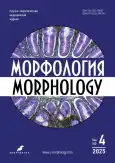Соотношение пролиферации и апоптоза в клетках соединительных тканей кожи при заживлении механической травмы в эксперименте
- Авторы: Березовская Т.И.1, Одинцова И.А.1
-
Учреждения:
- Военно-медицинская академия им. С.М. Кирова
- Выпуск: Том 163, № 4 (2025)
- Страницы: 327-338
- Раздел: Оригинальные исследования
- URL: https://bakhtiniada.ru/1026-3543/article/view/349037
- DOI: https://doi.org/10.17816/morph.677204
- EDN: https://elibrary.ru/KVVQXI
- ID: 349037
Цитировать
Аннотация
Обоснование. Важным аспектом течения раневого процесса являются процессы пролиферации и апоптоза в зоне повреждения. Особый интерес представляет характеристика регенерационного гистогенеза тканей кожи в перинекротической области раны, а именно соединительнотканные слои — дерма и гиподермис. Специфика перинекротической области состоит в том, что в ней располагаются камбиальные элементы эпителиальных и соединительных тканей, за счёт которых осуществляется регенерация, а процессы клеточной гибели имеют характерные особенности. Для изучения закономерностей гистогенетических процессов, в том числе пролиферации и клеточной гибели, в тканях с различной камбиальностью чаще всего используют иммуногистохимические методы. Однако по-прежнему сохраняет свою актуальность проблема выбора маркеров, отражающих соотношение процессов пролиферации и апоптоза на разных этапах регенерации.
Цель — провести иммуногистохимическую оценку соотношения пролиферации и апоптотической гибели клеток соединительных тканей кожи на разных этапах заживления механической раны.
Методы. Проведено экспериментальное одноцентровое сплошное контролируемое рандомизированное неослеплённое исследование. Материалом служили образцы кожи бедра крыс линии Wistar на разных этапах заживления после механического повреждения (нанесения глубокой резаной раны). Животных разделили на 9 групп: контрольная группа — интактные крысы (n = 3); остальные группы соответствуют срокам после нанесения механической травмы — 12 ч, 24 ч, 2, 3, 6, 10, 15 и 25 суток (n = 3 в каждой группе). Из фрагментов кожи готовили препараты для гистологического и иммуногистохимического исследования. Для выявления процессов пролиферации использовали антитела к фосфорилированному гистону Н3, для выявления апоптоза — антитела к белку р53 и каспазе 3.
Результаты. В соединительных тканях кожи крыс всех экспериментальных групп обнаружены иммунопозитивные клетки, экспрессирующие фосфогистон Н3, каспазу 3 и белок р53. Определён индекс пролиферации клеток и проанализирована динамика экспрессии проапоптотических белков в интактной коже и в перинекротической области на разных этапах процесса регенерации. На основании полученных данных были рассчитаны пролиферативно-апоптотическое соотношение и числовой показатель (индекс), характеризующий оба процесса. Показано, что пролиферативно-апоптотический индекс достигает наиболее высоких значений в периоды преобладания пролиферации над процессами клеточной гибели — в интактной коже и на завершающих этапах регенерации, минимальные значения индекс принимает при преобладании процессов апоптоза — в фазу воспаления и некроза.
Заключение. В работе впервые использована иммуногистохимическая реакция с антителами к фосфогистону Н3 для исследования процесса регенерации кожной раны. Этот маркер экспрессируется пролиферирующими клетками и в совокупности с маркерами апоптоза позволяет определить пролиферативно-апоптотическое соотношение на разных этапах регенерации.
Ключевые слова
Полный текст
Открыть статью на сайте журналаОб авторах
Татьяна Ионовна Березовская
Военно-медицинская академия им. С.М. Кирова
Автор, ответственный за переписку.
Email: lapi2@yandex.ru
ORCID iD: 0009-0009-1591-9152
SPIN-код: 2508-7042
Россия, Санкт-Петербург
Ирина Алексеевна Одинцова
Военно-медицинская академия им. С.М. Кирова
Email: odintsova-irina@mail.ru
ORCID iD: 0000-0002-0143-7402
SPIN-код: 1523-8394
д-р мед. наук, профессор
Россия, Санкт-ПетербургСписок литературы
- Deev RV. Programmed cell death: new nomenclature. Morphology. 2024;162(3):340–346. doi: 10.17816/morph.642457 EDN: FAEUVI
- Reva IV, Reva GV, Odintsova IA. Immunohistochemical characteristics of biopsies of pathologically altered gastric mucosa. In: Makiev RG, Odintsova IA, editors. Innovative technologies for studying histogenesis, reactivity and tissue regeneration (Proceedings of the Military Medical Academy). Saint Petersburg: Military Medical Academy; 2024. P:136–141. (In Russ.) EDN: BZAWGC ISBN: 978-5-94277-106-5
- Demyashkin GA, Uruskhanova, ZhE, Koryakin SN, et al. Renal proliferation and apoptosis against ascorbic acid administration in a model of acute radiation nephropathy. Morphology. 2024;162(1):16–30. doi: 10.17816/morph.629410 EDN: LVBGZW
- Hu S, Xu Y, Meng L, et al. Curcumin inhibits proliferation and promotes apoptosis of breast cancer cells. Exp Ther Med. 2018;16(2):1266–1272. doi: 10.3892/etm.2018.6345
- Xie R, Tang J, Zhu X, Jiang H. Silencing of hsa_circ_0004771 inhibits proliferation and induces apoptosis in breast cancer through activation of miR-653 by targeting ZEB2 signaling pathway. Biosci Rep. 2019;39(5):BSR20181919. doi: 10.1042/BSR20181919
- Demyashkin GA, Atyakshin DA, Yakimenko VA, et al. Characteristics of proliferation and apoptosis of hepatocytes after administration of ascorbic acid in a model of radiation hepatitis. Morphology. 2023;161(3):31–38. doi: 10.17816/morph.624714 EDN: LDQCJS
- Kotov VN, Kostyaeva MG, Ibadullaeva SS, et al. Regulatory role of protein p53 in the functional activity of the central nervous system. Morphology. 2023;161(4):113–128. doi: 10.17816/morph.629463 EDN: FGSFQU
- Chumasov EI, Maistrenko NA, Romashchenko PN, et al. Immunohistochemical study of the sympathetic innervation of the colon in chronic slow-transit constipation. Experimental and Clinical Gastroenterology. 2022;11(207):191–197. doi: 10.31146/1682-8658-ecg-207-11-191-197 EDN: PXTDXG
- Shi Y, Zhao Y, Zhang Y, et al. TNNT1 facilitates proliferation of breast cancer cells by promoting G1/S phase transition. Life Sci. 2018;208:161–166. doi: 10.1016/j.lfs.2018.07.034
- Korzhevskii DE, Kirik OV, Petrova ES, et al. Theoretical foundations and practical applications of immunohistochemical methods: A guide. Saint Petersburg: SpetsLit; 2014. (In Russ.) EDN: SINOMT ISBN: 978-5-299-00596-7
- Campoy EM, Branham MT, Mayorga LS, Roqué M. Intratumor heterogeneity index of breast carcinomas based on DNA methylation profiles. BMC Cancer. 2019;19(1):328. doi: 10.1186/s12885-019-5550-3 EDN: YEIARD
- He J, Chen Y, Cai L, et al. UBAP2L silencing inhibits cell proliferation and G2/M phase transition in breast cancer. Breast Cancer. 2018;25(2):224–232. doi: 10.1007/s12282-017-0820-x EDN: ZDLVRG
- Zhou Y, Shen JK, Yu Z, et al. Expression and therapeutic implications of cyclindependent kinase 4 (CDK4) in osteosarcoma. Biochim Biophys Acta Mol Basis Dis. 2018;1864(5 Pt A):1573–1582. doi: 10.1016/j.bbadis.2018.02.004 EDN: YFWUST
- Diatlova AS, Dudkov AV, Linkova NS, Khavinson VKh. Molecular markers of caspase-dependent and mitochondrial apoptosis: the role of pathology and cell senescence. Advances in Modern Biology. 2018;138(2):126–137. doi: 10.7868/S0042132418020023 EDN: XMRNSH
- Hashimoto N, Nagano H, Tanaka T. The role of tumor suppressor p53 in metabolism and energy regulation, and its implication in cancer and lifestyle-related diseases. Endocr J. 2019;66(6):485–496. doi: 10.1507/endocrj.EJ18-0565 EDN: BTRYWO
- Kudinova EA, Bozhenko VK, Kulinich TM, et al. Evaluation of the ratio of proliferation and apoptosis in breast tissue in normal and hyperproliferative processes. Bulletin of the Russian Scientific Center of Radiology. 2019;19(2):25–39. EDN: PUMEVI
- Danilov RK. The doctrine of tissue cambiality as a histogenetic basis for understanding the mechanisms of the wound process. In: Morphology issues of the 21st century. Saint Petersburg: DEAN; 2010. P:34–38 ISBN: 978-5-93630-792-8
Дополнительные файлы

















